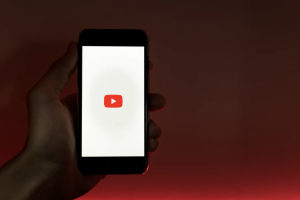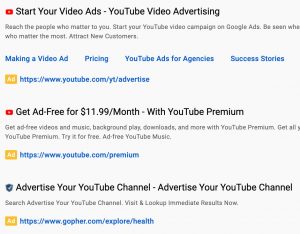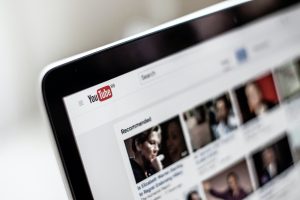

Who are you?
YouTube is an online video-sharing service. Former PayPal employees Steve Chen, Chad Hurley, and Jawed Karim registered it on February 14th, 2005 under the name “PayPal.com”. Ordinary people would enjoy sharing “home videos,” they reasoned (Hosch, 2021). Behind Google’s search engine, YouTube has the world’s second-largest (which owns YouTube). People use YouTube to find information on a variety of topics, which leads to an increase in the number of videos related to those topics. People can easily upload videos to YouTube and then share them with others. Videos on YouTube can be about anything, as long as someone is willing to upload a video about it. These videos can easily be shared on other social media platforms, emailed, or posted on other websites, with or without embedding. Incorporating features such as demographic targeting, topics, or interests, YouTube allows businesses to promote their videos to people who may be interested in them (Queensland Business, 2021).

Since its launch in 2005, YouTube has grown to be the most popular place for people to watch videos online. Google purchased YouTube in late 2016 and now controls 11% of global video traffic, making it the second most popular video service after Netflix. With over 1 billion active users and more than half of all views coming from mobile devices, YouTube is a huge success.
Using interactive videos to build a following has never been easier, thanks to YouTube’s overwhelming dominance. YouTube allows users to create and manage their own channels, which they can use to further their business goals. Companies can also use YouTube to advertise on other channels’ video content in addition to their own (Jenkins,2017).
The “secret” to getting rich
YouTube videos are viewed for more than a billion hours every day, and 400 hours of new content are uploaded every minute. Advertising is YouTube’s primary source of revenue. It also makes money from monthly subscriptions, such as YouTube Premium, and has developed tools to assist eligible creators in earning money in a variety of ways, including Super chat, channel memberships, and merchandise. In most cases, revenue from those channels is split between the creators and YouTube.

Large brands, celebrities and many other Youtube exclusive influencers use the platform to promote themselves and make money through YouTube. The majority of Youtube’s revenue comes from advertising, and it accounts for 11% of Google’s net US ad revenue. When it comes to revenue, the subscription-based business model is still a secondary one for the company (Dutta,2020).
In the United States, YouTube’s net advertising revenues are expected to reach 4.34 billion dollars in 2020, up from 3.88 billion dollars in 2017. In that year, the video platform generated global net ad revenues of $7.8 billion (Guttmann,2021). Nearly 19.77 billion dollars in worldwide advertising revenues were generated by YouTube in 2020, up from 15.15 billion dollars in the previous fiscal period. When compared to Google Search, Alphabet’s own online video platform makes less money, but it is still a significant source of revenue (Statista Research Department,2021).
It has to be said that YouTube is not only a daring experiment, but also a huge success. According to Richter (2021), YouTube’s ad revenue is dwarfed by the total revenue of the world’s most popular video streaming service, by did the math.
The user is primarily responsible for providing content to the platform. However, given their clear role in managing the content they distribute and the growing importance of YouTube, Facebook Video, and others in commissioning original content, this is debatable (Napoli & Caplan, 2017).
Can I believe everything I see?
YouTube was created as a platform for amateur video sharing. However, users and media commentators have expressed concern about the authenticity of the videos on the site, with some users and media commentators questioning whether some videos are covert advertisements masquerading as entertainment or user-generated media (Freeman&Chapman,2007,p.209). “Any ad can be made into one that has all of the attributes of any YouTube video; it can be shared, embedded in other sites, and commented on, with the user firmly at the controls,” writes Catherine Taylor,18 of the marketing trade journal Brandweek.

Users of social media platforms have new opportunities to communicate and interact with a wider range of people, forming networked publics (Boyd,2011,p.39). Digital inter-mediaries are becoming more and more powerful, which necessitates revisiting difficult questions about how they structure speech and social activity and what rights and responsibilities should go along with it (Gillespie et al., 2018, p.254).
Is being in the spotlight a good thing?
In January 2008, Corey Delaney made headlines when a party he hosted while his parents were away went out of control, and videos of him refusing to remove his sunglasses and apologize went viral on YouTube. In just a few days, there were websites dedicated to the teen “party planner,” often featuring Cory’s now-famous yellow sunglasses or celebrity photos with slogans like “Not me.” Another site launched a game to bring the naughty teen back to reality, amplifying the incident and the negative feedback loop between online culture and mainstream media, causing great distress and even disruption to the teen and his family. (Burgess, Green & Hartley, 2013, p.100-101).
On February 13, 2008, a completely different national media event occurred. Australia’s prime minister’s formal apology to Australia’s indigenous people, particularly the “stolen generations,” is a speech act in and of itself, not just an act of listening, because without hundreds of former government policies influencing the story of the sympathy fusion, it is impossible to have a meaningful official apology (Burgess, Green & Hartley, 2013, p.102).

Ironically, the top search result for “Australia” and “sorry” was a clip from the “Current Affairs” section showing Corey Delaney refusing to apologize for his actions on the eve of the official apology. The entire ABC broadcast was eventually uploaded to YouTube, where it was viewed by several hundred people by the end of the day. YouTube’s most popular pages in Australia began to fill up with related videos over the next 24-48 hours.
On these videos, the text commentary reflects the specific YouTube politics-involvement culture of highly emotional, overly “yes” or “no” comments, where raw racism is countered by equally raw moralization. It’s a dogfight for attention between two equally valid points of view (Burgess, Green & Hartley, 2013; p.103).
Jose van Dijck, Thomas Poell, and Martijn de Waal conducted an in-depth examination of platforms’ influence on social life in their book The Platform Society: Public Values in a Connected World (Oxford University Press, 2018).
Their book starts with the premise that platforms are now receiving critical services like news and public transportation. However, the platform frequently shirks the social responsibility entailed by these critical social functions due to its ambiguous identity and its own position as an intermediary.
The hugely popular YouTube alternatives in parts of the world with strong local content traditions, such as China and South Korea, suggest that YouTube’s potential as a “global” service is limited (Burgess,Green & Hartley,2013,p.107).
Ready to go
Sustaining growth is a major concern for YouTube’s future. It will be crucial to strike a balance between mass popularization (which YouTube has attained for the time being), innovation, and sustainability (which require long-term investment and a stable and socially functioning community). Platform providers would be wise to cultivate and protect new relationships of power and responsibility with users as a result of the new economics of value co-creation. YouTube, like all enterprises that rely on user co-creation, must maintain its scale and rate of growth while supporting cultural and aesthetic diversity and respecting the agency of the communities of users who work to produce its various forms of value – whether economic, cultural, or social (Burgess, Green, & Hartley, 2013, p.104).
Reference List
Boyd, D. (2011). Social network sites as networked publics: Affordances, dynamics, and implications. In Z. Papacharissi (Ed.), A networked self: Identity, community, and culture on social network sites (pp. 39–58). New York: Routledge.
Burgess, J.,Jean E., Green, J., Jenkins, H., & Hartley, J. (2013). YouTube : online video and participatory culture. (2nd ed.). Wiley.
Business Queensland, Queensland Government.(2020,June 8).Using Youtube to market your business.
Dutta,A.(2020,Aug 18). Youtube Business Model|How does Youtube make money?
https://www.feedough.com/youtube-business-model-how-does-youtube-make-money/
Freeman, B., & Chapman, S. (2007). Is “YouTube” telling or selling you something? Tobacco content on the YouTube video-sharing website. Tobacco Control, 16(3), 207–210. https://doi.org/10.1136/tc.2007.020024
Flew, T. Martin, F. & Suzor, N. (2019). Internet regulation as media policy: Rethinking the question of digital communication platform governance. Journal of Digital Media & Policy, 10(1), 33–50.
Gillespie, Tarleton. (2018). Governance by and through Platforms. The SAGE handbook of social media.
Guttmann,A.(2021,Apr 23).Net advertising revenues of YouTube in the United States from 2018 to 2022.
https://www.statista.com/statistics/289660/youtube-us-net-advertising-revenues/
Hosch,W.L. (2021,Sep 15). Youtube Web site.
https://www.britannica.com/topic/YouTube
Jenkins,L.D., Social Media Examiner.(2017, Nov 16). Youtube Marketing:The Ultimate Youtube for Business Guide.
https://www.socialmediaexaminer.com/youtube-marketing-ultimate-youtube-business-guide/
Napoli, P., & Caplan, R. (2017). Why media companies insist they’re not media companies, why they’re wrong, and why it matters. First Monday, 22(5). https://doi.org/10.5210/fm.v22i5.7051
Richter,F.(2021,Apr 28). YouTube’s Ad Business Is Almost Matching Netflix in Revenue.
https://www.statista.com/chart/24748/youtube-advertising-revenue-vs-netflix-revenue/
Statista Research Department.(2021,Aug 23).Worldwide advertising revenues of YouTube from 2017 to 2020.
Van Dijck, J., Poell, T., & de Waal, M. (2018). The Platform Society: Public Values in a Connective World. Oxford University Press USA – OSO.